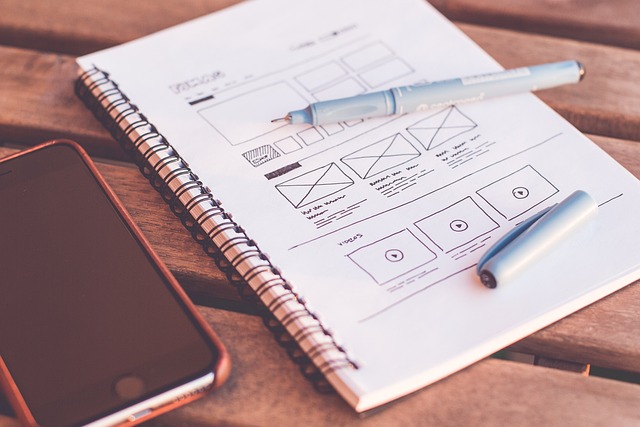In today's digital world, a website is a business's primary gateway to customers. An outdated or poorly designed site can harm brand perception and user engagement. A successful web redesign goes beyond aesthetics, focusing on functionality, usability, market trends, new technologies, fresh content, and fast loading times. It involves a user-centric approach, responsive design, professional aesthetics, and SEO strategies. This strategic move boosts user experience across devices, enhances online visibility, drives organic traffic, and contributes to business growth. Choosing the right web design agency is crucial for success, followed by implementation, testing, and measuring KPIs for continuous improvement.
In today’s competitive digital landscape, a website isn’t just an online business card; it’s your virtual storefront. Web design plays a pivotal role in captivating audiences, converting visitors into customers, and staying ahead of the curve. This article guides you through every step of the website redesign process, from identifying the pressing need for a refresh to choosing the right web design agency. By understanding key components of effective web design services, implementing successful strategies, and measuring success, you’ll ensure your new website drives tangible results.
Understanding the Need for Website Redesign

In today’s digital era, a website is often a business’s storefront and primary means of communication with customers. However, having an outdated or poorly designed website can be detrimental to a brand’s online presence and user experience. This is where understanding the need for web design redesign services becomes crucial. An existing site might not be optimized for modern users, who increasingly expect seamless navigation, fast loading times, and visually appealing interfaces on every platform.
Redesigning your website isn’t just about aesthetics; it involves evaluating its functionality, usability, and alignment with current market trends. Outdated web design can lead to high bounce rates, lower search engine rankings, and an overall poor user experience. By refreshing your site’s look and feel, integrating new technologies, and keeping content fresh, businesses can ensure their online platforms remain engaging, accessible, and effective in attracting and retaining users.
Key Components of Effective Web Design Services

When it comes to effective web design services, several key components stand out as essential. Firstly, a user-centric approach is paramount. The website should be intuitive and easy to navigate, with a clean layout that enhances user experience. Responsive design is another crucial aspect; ensuring the site adapts seamlessly to various devices and screen sizes is vital for accessibility and engagement across different platforms.
Visual appeal is also significant in modern web design. A compelling, professional design, including well-chosen colours, typography, and imagery, can significantly boost brand perception. Moreover, integrating search engine optimisation (SEO) strategies from the outset guarantees better online visibility and drives organic traffic to the site.
Benefits of Refreshing Your Online Presence

A website redesign can be a powerful tool for businesses looking to stay relevant and competitive in today’s digital landscape. By refreshing your online presence, you gain a fresh perspective on user experience, which is crucial for engagement and conversion rates. Modern web design incorporates responsive layouts that seamlessly adapt to various devices, ensuring your site looks vibrant and functions flawlessly across desktops, tablets, and smartphones. This mobile-first approach is essential in a world where a significant portion of internet traffic comes from mobile sources.
Additionally, an updated website can significantly boost your search engine optimization (SEO). Fresh content and optimized coding practices enhance your site’s visibility on search engines like Google, driving organic traffic and increasing brand awareness. With a redesigned site, you have the opportunity to showcase your brand’s evolving identity, appeal to a wider audience, and establish yourself as an industry leader, ultimately driving business growth and success online.
Strategies for a Successful Website Redesign Process

A successful website redesign process involves careful planning and strategic execution. The first step is to thoroughly understand your brand, target audience, and business goals. This knowledge will guide the entire redesign, ensuring that the new site aligns with your branding and serves its intended purpose effectively. Conducting thorough user research, analyzing competitor websites, and setting clear objectives are essential tactics in this phase.
Once the foundation is laid, create a detailed plan outlining the new website’s structure, content hierarchy, and visual design. This involves wireframing and prototyping to visualize the site’s layout and functionality. Collaborate with your web design team to make informed decisions about color schemes, typography, and overall aesthetics, ensuring a cohesive user experience across all devices. Regular testing and iterative improvements will refine the website, making it not just visually appealing but also user-friendly and optimized for search engines (Web Design).
Choosing the Right Web Design Agency

When considering a website redesign, selecting the ideal web design agency is a pivotal step. It’s crucial to align your project with a team that understands your brand vision and can bring it to life effectively. Research is key; examine their portfolio, past client testimonials, and case studies to gauge their expertise and style. Look for agencies specialising in modern, responsive designs that cater to current user expectations.
Additionally, consider their process and communication methods. Effective collaboration relies on clear, consistent dialogue throughout the project lifecycle. Ensure they offer a comprehensive range of services, from initial concept and design to development, testing, and ongoing maintenance, ensuring a seamless transition with minimal disruption to your business operations.
Post-Redesign Implementation and Testing

After a successful website redesign, the implementation and testing phase is crucial in ensuring the new design translates into improved user experience. This process involves deploying the updated website and subjecting it to rigorous quality assurance checks. The first step is to verify that all elements of the redesign are functional across various devices and browsers, ensuring compatibility and responsiveness. This includes thorough testing on desktops, tablets, and mobile phones to guarantee a seamless experience for every visitor.
Additionally, post-redesign testing focuses on performance optimization, checking page load times and overall site speed. It also involves user acceptance testing (UAT), where actual users provide feedback on their interactions with the new site. This valuable insight helps identify any usability issues or areas that may need further refinement to align perfectly with user expectations and goals, ultimately enhancing the overall effectiveness of the Web Design.
Measuring Success and Future Optimization

Measuring success is a vital step in any web design project, especially after a redesign. It involves tracking key performance indicators (KPIs) to gauge the effectiveness of the new site. This could include metrics like user engagement, conversion rates, bounce rates, and time spent on pages. By analyzing these data points, you can identify what’s working well and what needs improvement. For instance, if a higher percentage of visitors are completing purchases, it suggests that the redesigned website is driving more conversions. Conversely, if bounce rates have increased, it might indicate issues with site navigation or content relevance.
Future optimization relies heavily on these insights. By understanding user behavior and preferences, designers and developers can make data-driven decisions to further enhance the website. Regular audits and A/B testing can help maintain the site’s performance and keep it relevant in an ever-evolving digital landscape. This continuous improvement process ensures that the web design remains not just appealing but also functional and aligned with user expectations.
